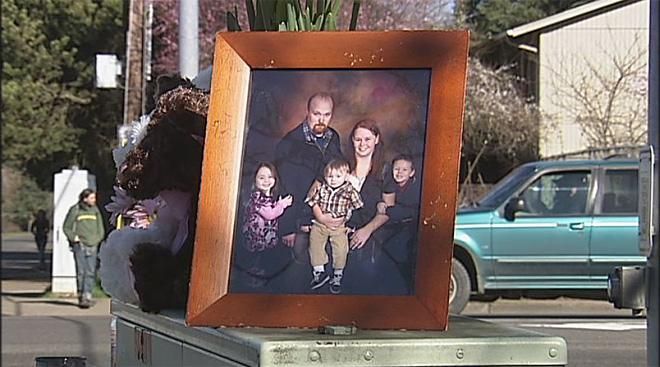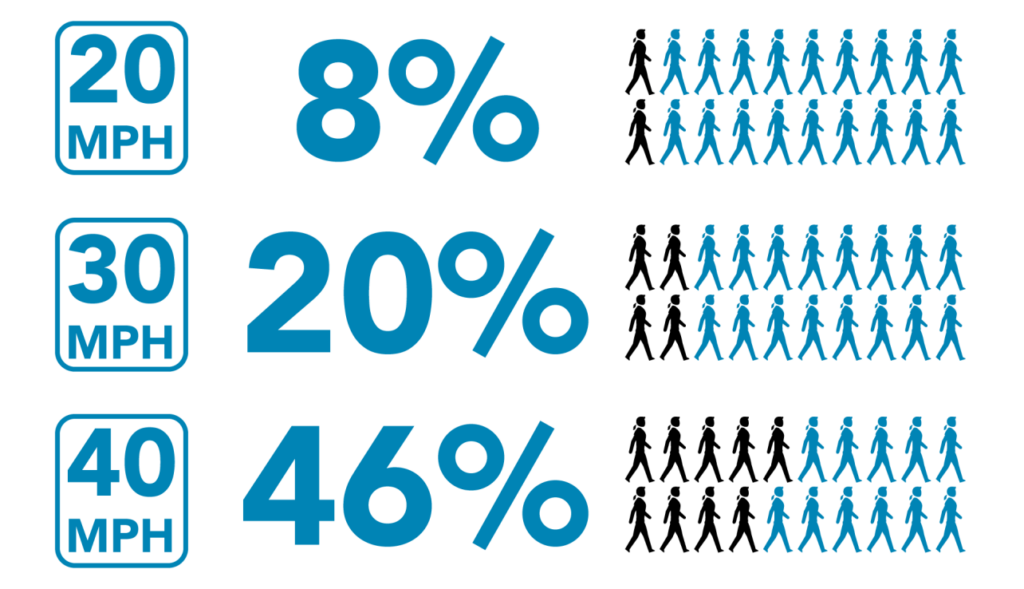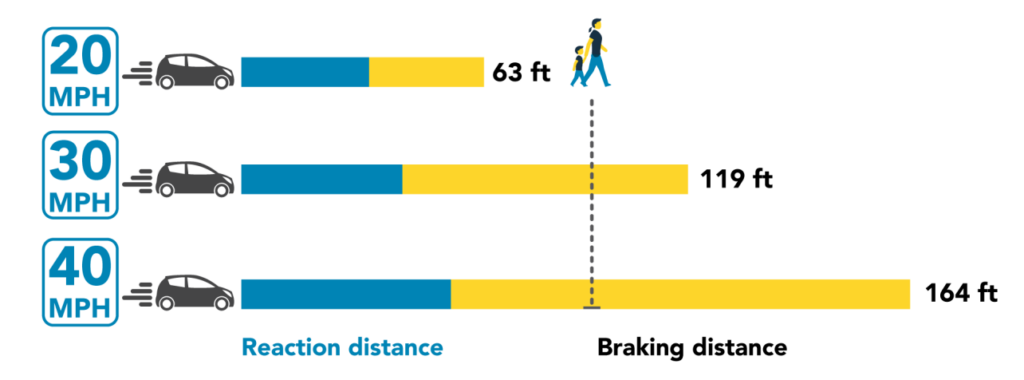Ten years after 3 kids were killed, we must prioritize safety over speed
A decade later, the best way to honor those we lost is to redesign Main Street to protect the people we have.

Ten years ago today, a man driving west on Main Street through Springfield ran a red light at 54th Street, hitting and killing three kids. The driver was not under the influence of alcohol but apparently lost attention. The kids and their mother, who was also hit but not killed, were legally crossing Main Street in a marked crosswalk with a green light.
Response
The community turned out to support the family and created a memorial near where the kids perished. People also called for improvements to Main Street to prevent future tragedies.
According to the City of Springfield, “Main Street is consistently ranked as one of the most unsafe city streets in Oregon based on the severity and frequency of traffic crashes. The Oregon Department of Transportation and the City must address this problem to save lives, reduce injuries, and lessen property damage due to crashes. The purpose of the Main Street Safety Project is to select infrastructure solutions that will make Main Street safer for people walking, biking, driving, and taking transit.”
But seven years after the deaths, “the Springfield City Council adopted a resolution to create an alternative plan for Main Street safety improvements. This action means the existing Draft Facility Plan is not moving forward for further consideration.”
Today, the City of Springfield does not appear to be working towards such an alternative plan. Indeed, Main Street hasn’t even been mentioned during recent State of the City addresses.
According to KLCC, the Oregon Department of Transportation has taken these actions since the crash:
- In 2014, countdown pedestrian signal heads were installed
- In 2015, reflectorized backplates were installed on the signal heads
- In July 2016, the speed limit changed to 35 mph (from 40) through this intersection
- In 2019, Safety Quick Fix funding was used to implement split phasing signal timing on side street approaches as interim solution until construction project was completed (maintenance forces used to complete this interim solution)
- In December 2024, the Main Street & 54th Street project was completed at a cost of $1,989,141.
- Project installed new curb ramps, left turn lanes on the side streets, flashing yellow arrow on side streets, new intersection illumination, new signs and new pavement arrows at the intersection.
- We also implemented a signal timing feature where if the pedestrian push button is activated, the flashing yellow arrow will NOT come up (only a protected green arrow for the left turns) for any of the left turn lanes.
While these actions are welcomed, they likely would not have prevent the tragedy a decade ago.
Need to prioritize safety over speed
Main Street through Springfield is like thousands of others across the country: a 5-lane, undivided state highway that is dangerous by design: intended more for people to drive fast than for people to walk safely.
As the Vision Zero Network explains, higher speeds are more deadly for two reasons.
First, higher vehicle speeds significantly increase likelihood of death. Our bodies can only tolerate so much physical impact. Even small increases in vehicle speed significantly escalate risk of severe injuries and deaths.

Second, higher speeds increase a driver’s reaction time and braking distance. We will always face unpredictable, urgent reasons to stop. The speed we’re traveling can make the difference between life and death.

You might think that the solution would be to lower the posted speed limit, as has already been done on Main Street. But most of us tend to drive at the speed that feels safe—to us as drivers. In the heart of Eugene, where Broadway has two narrow lanes with a median planted with trees, few would feel safe driving faster than 20 mph. On the other hand, with five wide lanes, more than Interstate-5 has in rural areas, driving 50 mph or more can feel safe on Main Street—for people driving.
The solution for Main Street is to change the design to so that people will naturally drive at safer speeds. For example, the City of Portland has been experimenting with “rose lanes”: painting the two outer lanes to be limited to buses and right turns, thereby channeling through traffic into the two inner lanes. Doing so naturally causes traffic to slow down—without the need for expansive infrastructure improvements, or adverse impacts on local businesses.
Best of all, as it is only paint, a community can try such an approach and easily reverse course if it doesn’t work out. The City of Eugene did just that with South Willamette Street, restriping lanes for a one-year trial, making it permanent only after the approach had proven to work.
A decade later, the best way to honor those we lost is to redesign Main Street to prioritize the safety of those we have.
See also
Further reading
Stories about safety on Main Street from the last decade:
2025
2024
- Lane closures on OR 126B start next week (ODOT, 8/8/24)
- BEST argues for increasing investments in transportation safety statewide (BEST Blog, 6/27/24)
- Main Street: ODOT changing dangerous Springfield intersection, but more is needed (BEST Digest, 4/18/24)
- VIDEO: ODOT working on 54th and Main Street in Springfield (KEZI, 4/15/24)
- ODOT changing Main Street intersection where three kids were killed, more is needed (BEST Blog, 4/12/24)
- Work starts soon in Springfield (ODOT, 3/28/24)
2023
- Better Streets for People and Businesses: How can we build community together? (BEST Digest, 10/9/23)
- Community members talk safety, future of Springfield’s Main Street (KEZI, 10/5/23)
- PROGRAM: Better Streets for People and Businesses (Springfield City Club, 10/5/23)
- VIDEO (Springfield City Club at Facebook)
- PRESENTATION (BEST at Google Slides)
- On Thursday, October 5, attend the Springfield City Club with Rob Zako (BEST Digest, 10/4/23)
- Main Street: City of Springfield not moving forward with safety plan (BEST Digest, 9/8/23)
- ODOT planning safety changes to Springfield intersection (KEZI, 2/27/23)
- Online Open House — Intersection Safety Project: OR 126B at 54th Street (ODOT, 2/27/23)
- BEST remembers 3 children killed 8 years ago, works to prevent future tragedies (BEST Digest, 2/22/23)
- Analysis: The trouble with Main Street (Claire Shanley, Chronicle, 2/9/23)
- 54th & Main Street in Springfield: Through February 28, see ODOT’s proposed changes (BEST Digest, 1/31/23)
- A Spirit of Courage: Springfield Mayor Sean VanGordon gives State of the City address (KEZI, 1/19/23)
2022
- The Trouble with Main Street (Claire Shanley, Medium, 11/21/22)
- Rob Zako: Pedestrian safety requires political will (Whole Community News, 7/14/22)
- Springfield scraps Main Street draft facility plan, new approach in the works (Register-Guard, 6/29/22)
- Main Street: Springfield City Council tosses out draft plan to improve safety (BEST Digest, 6/23/22)
- Springfield pumping the brakes on Main Street project amid community concerns (Register-Guard, 5/11/22)
- Springfield will not move forward with proposed Main Street changes (KVAL, 6/21/22)
- Springfield businesses raise concerns about Main Street project (KEZI, 3/3/22)
- Some Springfield businesses & residents not happy with Main Street Safety Project (KVAL, 2/16/22)
- Some Springfield residents not happy with proposed Main Street Safety Project (KMTR, 2/15/22)
- Some unhappy with direction of Main Street Safety Project in Springfield (KEZI, 2/14/22)
2021
- Springfield Ward 1 candidates offer views on making streets safer (BEST Blog, 3/1/21)
- Transportation Safety Questionnaire for Springfield City Council Ward 1 Candidates (BEST Blog, 2/28/21)
2020
- Springfield candidates offer views on making streets safer (BEST Blog, 4/28/20)
- Transportation Safety Questionnaire for City of Springfield Candidates (BEST Blog, 4/28/20)
2018
- Time running out to comment on Main Street upgrades (Register-Guard, 11/26/18)
- Springfield seeks input to make Main Street safer (KMTR, 11/8/18)
- Springfield residents who don’t feel safe on Main Street share input with City (KVAL, 11/8/18)
2017
- Gross Negligence (Strong Towns, 11/1/17)
- ‘Protect the wound that keeps getting ripped open’: Mother removes Main St. memorial (KMTR, 6/12/17)
- ‘They deserve the respect’: Mother removes memorial for children after repeated vandalism (KVAL, 6/12/17)
- Mother of 3 children killed by driver in Springfield said someone put kids’ items in boxes (KMTR, 6/11/17)
- Springfield mother of kids killed by driver said someone put memorial items in boxes (KVAL, 6/11/17)
- Man serving jail time after disturbing children’s memorial (KMTR, 1/23/17)
- Man who stole from Springfield memorial will serve jail time (KVAL, 1/23/17)
2016
- Springfield plans to create new memorial for 3 children killed (KMTR, 11/1/16)
- Springfield and Safeway fund new memorial for 3 kids killed on Main Street (KVAL, 11/1/16)
- Police: Man abused memorial to children hit, killed on Main Street in Springfield (KMTR, 10/31/16)
- Police: Man abused memorial to 3 children hit, killed in crosswalk on Main Street (KVAL, 10/31/16)
- Springfield City Council to discuss Main Street safety campaign (Register-Guard, 9/5/16)
- EDITORIAL: Making it safer (Register-Guard, 8/5/2016)
- State acts on deadly four miles of Main (Register-Guard, 8/4/2016)
- Speed Limit Reduced On Deadly Stretch of Springfield’s Main Street (KLCC, 8/4/16)
- Speed limit falls to 35 mph on Hwy 126/Main Street in Springfield (KMTR, 8/2/16)
- Speed limit drops to 35 mph on Hwy 126/Main Street in Springfield (KVAL, 8/2/16)
- Springfield, LTD drop plan to widen Main Street by more than 30 feet (Register-Guard, 7/19/2016)
- Vision Zero’s Vision—No Traffic Deaths (AARP, 7/1/16)
- MARINA HAJEK & STEVE MOE: Let’s slam the brakes on rising traffic fatalities (guest viewpoint, Register-Guard, 4/20/16)
- Main-McVay entering 2nd phase (Springfield Times, 3/3/16)
- Vigil for 3 children killed on Main Street one year ago (KMTR, 2/22/16)
- Vigil honors memory of 3 children killed in crosswalk one year ago (KVAL, 2/22/16)
- Attorney: Parents of children killed in crosswalk will drop lawsuit threat if street is renamed (Register-Guard, 2/14/2016)
2015
- EDITORIAL: Fixing Springfield’s Streets—Eugene provides a successful model (Register-Guard, 11/25/15)
- How to reduce traffic fatalities (Eugene Weekly, 9/28/15)
- Attorney: City liable in death of kids by ‘failing to make this area safer’ (KMTR, 8/20/16)
- Attorney: City liable in death of kids by ‘failing to make this area safer’ (KVAL, 8/20/15)
- DA: Under Oregon Law, LaThorpe can’t be charged with a crime (KMTR, 7/15/15)
- Police report: Driver ‘likely daydreaming’ when 3 kids killed (KVAL, 7/15/15)
- Just an accident (Strong Towns, 6/9/15)
- Springfield driver to pay $435 in deaths of three children—Larry LaThorpe says he’s “truly sorry” for a Feb. 22 accident in which he was convicted of careless driving (Register-Guard, 6/9/15)
- Driver who killed 3 kids pleads no contest to careless driving (KMTR, 6/8/15)
- Driver who killed 3 kids pleads no contest to careless driving (KVAL, 6/8/15)
- EDITORIAL: Three deaths, one ticket—Punishments don’t fit fatal crash case (Register-Guard, 5/21/15)
- City to move forward on Main-McVay transit study (Springfield Times, 5/21/15)
- Driver cited over crosswalk deaths—A Springfield man who struck three children faces a careless driving charge (Register-Guard, 5/19/15)
- Police: Driver who killed kids in crosswalk cited for careless driving (KMTR, 5/18/15)
- Police: Driver who killed kids in crosswalk cited for careless driving (KVAL, 5/8/15)
- EDITORIAL: When a tragic accident is just a tragic accident (Oregonian, 5/9/15)
- Safer Streets initiatives kicks off in Springfield (KMTR, 5/6/15)
- Driver who hit, killed kids may still face traffic citations, civil litigation (KMTR, 5/5/15)
- ‘She was almost to the curb with her children with ice cream cones’ (KVAL, 5/5/15)
- Oregon driver who ran red light, killed 3 children will face no charges (Oregonian, 5/5/15)
- No Criminal Charges Filed Against Driver Who Struck & Killed 3 Springfield Children (KLCC, 5/4/15)
- DA: Driver who hit and killed 3 kids in crosswalk won’t face charges (KMTR, 5/4/15)
- DA: Driver who hit and killed 3 kids in crosswalk won’t face charges (KVAL, 5/4/15)
- Traffic signals get needed improvements in Springfield (KMTR, 5/3/15)
- Main Street safety upgrades to begin—Starting today, workers will install reflective borders on traffic signals, and the city is eyeing red-light cams (Register-Guard, 5/3/15)
- License lost after crosswalk deaths—The DMV cites a medical condition and faults a driver in a Springfield accident that killed 3 kids (Register-Guard, 5/2/15)
- Project to make red lights more visible on Springfield’s Main Street (KMTR, 4/30/15)
- Project to make red lights more visible on Springfield’s Main Street (KVAL, 4/30/15)
- BOB PASSARO: Design streets that are safer for pedestrians (guest viewpoint, Register-Guard, 4/12/15)
- Children killed in crosswalk mourned—John Alysander Day, 8, McKenzie Mae Hudson, 5, and Tyler James Hudson, 4, are remembered by friends, family (Register-Guard, 3/28/15)
- Council, legislators talk Main Street solutions (Springfield Times, 3/12/2015)
- Springfield councilors urge immediate steps to improve Main Street safety—The City Council will evaluate other ideas after a fatal accident last month (Register-Guard, 3/10/2015)
- Springfield City Council to discuss Main Street safety (KMTR, 3/9/15)
- Springfield’s ideas after 3 kids die in crosswalk (KOIN, 3/8/15)
- Springfield considers intersection safety improvements after 3 children killed (Oregonian, 3/8/15)
- Kids’ deaths spur safety proposals—Springfield city leaders and residents will offer ideas to better safeguard pedestrians where 3 children died (Register-Guard, 3/8/2015)
- Father of the three children killed in crash thankful for outpouring (Register-Guard, 3/6/2015)
- Fatal crash driver says traffic light was green—He hasn’t been arrested or cited in the accident that killed three children in Springfield on Feb. 22 (Register-Guard, 3/5/2015)
- Planners to Discuss Future of Main St (KEZI, 3/6/15)
- Driver in Deadly Crash Speaks (KEZI, 3/5/15)
- DARCY WALLACE: Be kind, Springfield (guest viewpoint, Springfield Times, 3/5/2015)
- Local Businesses Fundraise for Family (KEZI, 2/28/15)
- Fundraisers for Springfield Family (KEZI, 2/27/15)
- Emotional Vigil Honors 3 Children (KEZI, 2/26/15)
- Springfield honors 3 young siblings killed in crosswalk—About 300 come out to remember the children who died on Main Street (Register-Guard, 2/26/15)
- Three children killed at 54th and Main (Springfield Times, 2/26/15)
- Driver In Fatal Springfield Crash May Have Run A Red Light (KLCC, 2/25/15)
- ‘It could be just citations for failure to yield to pedestrians’ (KVAL, 2/25/15)
- ‘We’re all thinking about ways to improve safety right now on east Main Street’ (KMTR, 2/25/15)
- Memorial, vigil honor 3 children hit and killed by pickup truck (KVAL, 2/25/15)
- Police: Witnesses say driver ran red light before hitting, killing 3 kids (KMTR, 2/25/15)
- Police: Witnesses say driver ran red light before hitting, killing 3 kids (KVAL, 2/25/15)
- Vigil Being Held for Tragedy (KEZI, 2/25/15)
- Driver in fatal Main Street crash went through red light, investigating officer says (Register-Guard, 2/25/15)
- Police identify people involved in deadly crash, plan to step up patrols (KMTR, 2/24/15)
- Police identify people involved in deadly crash in Springfield (KVAL, 2/24/15)
- Mother of 3 children killed by car upgraded to fair condition (KMTR, 2/24/15)
- ‘We just wanted to come by to show our sorrow for the family’ (KVAL, 2/24/15)
- Petition for Footbridge Started (KEZI, 2/24/15)
- Pedestrians Call Crossing Main St. Tough (KEZI, 2/24/15)
- Community Members Mourn Children Killed (KEZI, 2/24/15)
- SPD Says Driver Likely Ran Red Light (KEZI, 2/24/15)
- Fatal Accident Investigation Continues (KEZI, 2/24/15)
- EDITORIAL: Main Street work undone—Fatal pedestrian safety problems persist (Register-Guard, 2/24/15)
- Springfield grieves tragedy of children killed in accident—The deaths of 3 children at a Main Street intersection renew calls for safety (Register-Guard, 2/24/15)
- Deadly crash happened at intersection with state-of-the-art crosswalk (KVAL, 2/23/15)
- Police rule out alcohol as factor in crash that killed 3 children (KVAL, 2/23/15)
- Memorial takes shape at intersection where children died (KVAL, 2/23/15)
- Accident Survivor Reacts to Deadly Crash (KEZI, 2/23/15)
- Community Mourns for Crash Victims (KEZI, 2/23/15)
- Three children ages four to eight killed and their mother left critically injured after being struck by pickup truck at busy intersection (Daily Mail, 2/23/15)
- Neighbors decry intersection where 3 children died: ‘Too many people have been killed here’ (Oregonian, 2/23/15)
- 3 children die when pickup strikes them while crossing street (Oregonian, 2/23/15)
- 3 children killed while crossing Springfield street—A woman is critically injured at the intersection of 54th and Main streets (Register-Guard, 2/23/15)
- Police: Car hits, kills 3 children as they cross Main Street on foot in Springfield (KMTR, 2/22/15)
- Police: 3 kids crossing Main Street in crosswalk hit, killed by car (KVAL, 2/22/15)
- 3 Children Killed in Pedestrian Crash (KEZI, 2/22/15)